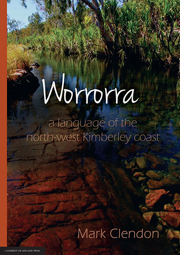Book contents
- Frontmatter
- Dedication
- Contents
- List of tables
- List of figures
- Abbreviations
- Acknowledgements
- Chapter One introduction
- Chapter Two segmental phonology
- Chapter Three morphophonology
- Chapter Four nouns and noun classes
- Chapter Five indicative mood and basic verbal morphology
- Chapter Six adjectives and inalienable nouns
- Chapter Seven pronouns, demonstratives, anaphors, deictics
- Chapter Eight optative, counterfactual and exercitive moods
- Chapter Nine number
- Chapter Ten adverbs and postpositional phrases
- Chapter Eleven complex predicates
- Chapter Twelve experiencer constructions
- Chapter Thirteen objects and possession
- Chapter Fourteen complement clauses
- Chapter Fifteen subjunctive verbs
- Chapter Sixteen middle voice
- Chapter Seventeen discourse cohesion
- Chapter Eighteen kinship terms
- Appendices
- References
Chapter Sixteen - middle voice
Published online by Cambridge University Press: 05 October 2014
- Frontmatter
- Dedication
- Contents
- List of tables
- List of figures
- Abbreviations
- Acknowledgements
- Chapter One introduction
- Chapter Two segmental phonology
- Chapter Three morphophonology
- Chapter Four nouns and noun classes
- Chapter Five indicative mood and basic verbal morphology
- Chapter Six adjectives and inalienable nouns
- Chapter Seven pronouns, demonstratives, anaphors, deictics
- Chapter Eight optative, counterfactual and exercitive moods
- Chapter Nine number
- Chapter Ten adverbs and postpositional phrases
- Chapter Eleven complex predicates
- Chapter Twelve experiencer constructions
- Chapter Thirteen objects and possession
- Chapter Fourteen complement clauses
- Chapter Fifteen subjunctive verbs
- Chapter Sixteen middle voice
- Chapter Seventeen discourse cohesion
- Chapter Eighteen kinship terms
- Appendices
- References
Summary
The term ‘middle’ in this chapter will serve as a rubric for what is essentially predicate valency-reduction fulfilling a variety of ends, all of which are marked on the verb by the morpheme -ye in form-order class [8], immediately to the right of the verb root. Paradoxically however, not all the uses to which middle morphology is put result in a reduced number of arguments for any given predicate.
As its adjacency to the root morpheme suggests, the morpheme -ye is derivational, creating formally intransitive from transitive verb roots. This morpheme performs reflexive, reciprocal, passive and antipassive operations; it is a ‘patientless antipassive’ and an ‘agentless passive’ morpheme in Dixon's (2002:535-536) typology, and a ‘backgrounding antipassive’ in Foley & Van Valin's (1984:338) exposition.
Starting with Austin (1981:151-157) this function with variations has been recognized in a number of Australian languages. Dixon (2002:206-207, 530-536) has proposed an ‘original’ pan-Australian valency-reducing morpheme *-dharri-, although he is not specific about the sense in which this form could have been original, as either a proto-form in phylogeny or in some other sense. From the first syllable he derives subsequent shapes -*dha-, -dhi-, -ji-, and -yi-. These forms are very widespread: they are found, for example, in the Gulf of Carpentaria, on Cape York and in the Lake Eyre Basin.
- Type
- Chapter
- Information
- WorrorraALanguage of the North-West Kimberley Coast, pp. 405 - 419Publisher: The University of Adelaide PressPrint publication year: 2014



